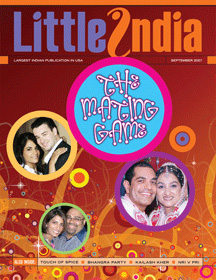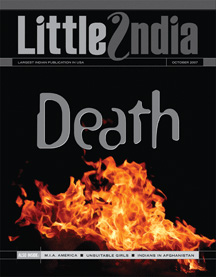Letters
Letters

|
Lavina Melwani’s article “Life and Death in America” is awesome. It brings tears and sadness. My husband and I came to the United States in the 1970s when we were 40 and now we see Yama’s call coming.Vikas Kamat’s experience after his father’s death and the rituals was touching. Many immigrants spent a lot of money sending bodies of their dear ones to India for cremation. Today things have changed as funeral homes facilitate the process and religious ceremonies are conducted by Indian priests. Some time ago, a dear friend died from a massive heart attack. The funeral home was able to conduct the ceremony here, including gathering the ashes after cremation in urns for immersion in the sea. Things are easier these days with the booming Indian population. The Indian consulate and airlines work with funeral homes with on documentation, death certificates, passports, etc. I am not that enthusiastic about having commercial outlets immersing the ashes for you. I believe it is far better to delegate a close relative or friend for the task. The article should have discussed the need for Indians to write wills, whose absence can be very problematic. Without a will the formalities can take months or years in courts. Some Indians are afraid to write wills, fearing it is akin to a death sentence. Tragically, even educated people fail to write wills with unfortunate consequences. I hope Little India will write a story to educate the community on the grief caused to families by the failure of a will.
Madhu Bhatia Jha’s article “Fading Ghungroos” echoed the sentiments of classical dancers everywhere. As a Bharathanatyam teacher myself, I find the state of classical dance in the U.S. and in India dismal. In trying to preserve and pass on the age-old tradition of praying through dance, Indians have forgotten its value and have immersed themselves into sanctifying Bollywood dances. Bollywood creeping into Bharathanatyam is unacceptable to me and I would like to see a reverse phenomenon. While I have nothing against Bollywood dances, the importance given to it over Bharthanatyam is saddening. Bollywood dancers are fun, but meant for light entertainment only. I am not a purist, but I tell my students that a Bharathanatyam dancer can do the filmi dances with ease due to the rigorous training their bodies have been through, but a Bollywood dancer will never be able to capture the nuances and intricacies of Bharathanatyam. Some of my students are good Bollywood dancers and that is only because they are excellent Bharathanatyam dancers. It is a sad state of affairs that great teachers have to include film dance in their schedule of classes merely to entice students into classical dance. Local organizations in the U.S. tend to prefer film dance items as opposed to classical dances. Again, there is nothing wrong with that, but in trying to preserve our heritage here, they must segregate a day to celebrate all our classical arts, be it dance, vocal or instrumental music. So is there a mid-way reconciliation here? Yes. Students can turn to neo-classical dances that allow the dancer to explore boundaries outside of classical arts, while still adhering to some standards and rules. But this can only happen if the student undergoes training in a classical dance form. Dancers like Chandraleka and Anita Ratnam have already paved the way for the younger generation in this new genre of classical dance. Like the late and great singer M.S.Subbulakshmi said, “Mothers need to keep the lamp of Sangita (classical and devotional music) burning in their households because that will promote Bhakthi….eventually world peace.” Parents have to emphasize the need for classical arts for that promotes our rich heritage, culture and traditions. Though fun, film dances do not reflect our way of life, nor do they represent one of the oldest cultures alive today. The question that parents and the children need to ask themselves – “Years from now, which would give you respect and a standing in society – as a Bollywood exponent or a Bharathanatyam exponent?” In the recent volley over “Invading the Sacred,” (October 2007) I am struck by how both scholars and devotees refer to Hindu “myths” vs. Christian scri pture, Hindu “pagan roots” and Hindu polytheism vs. Abrahamic monotheism. These subtle prejudices color our dialogue and we must oppose these. Is not the great holy person Jesus Christ a “man-god,” is not there a “Father, Son, and the Holy-Ghost” trinity in Christianity? Is not resurrection or coming down a mountain with commandments or turning water-into-wine a “myth.”
Prof Paul Courtright is correct in his de scri ption that a university is not an ashram. However, the manner in which he has conducted himself on the points raised by the Hindus on his book on Ganesh, he has patently not fulfilled his dharma to society. First, you admit that interpretations are hard to prove or disprove “Parsing the Sacred,” (Oct 2007). Yet interpretation is what is happening in this discussion. The word rectum is used one place, anus at another. The Sanskrit text seems to allude to buttock, not rectum nor anus. These are three different words with three different meanings, but used interchangeably. The text could be saying that asuras came from the buttocks region of the Purusha’s body; not necessarily out of the rectum. Second, it seems that the Puranas say that Daksha placed the garland on the bed intended for the couple. Which couple? It does not mention Sati directly or indirectly. Could it be that Daksha had sex with his own wife? Psychoanalysis is one thing, wild imagination is another. Thirdly, could animal act simply mean sex, meaning a biological, animal necessity? Not necessarily rape or any other imagined act. I think Paul Courtright is carried away by his quasi-scientific methodology. You write, ” scri ptures in the Hindu tradition are living, breathing documents, open to reinterpretation and reinvention by Hindus and non Hindus alike.” The scri ptures are God given. If this assertion is accepted, then reinvention is allowable. The discussion now is about puranas which are not scri ptures in the strictest sense. Even so, interpretation is a matter of opinion. Hence in the Hindu tradition, interpretation by onlyqualified scholars is allowed and must pass strict tests of logic before it is accepted. Any interpretation by any Tom, Dick and Harry is usually disdained in the Hindu tradition. I am not sure I believe the author has proven by his examples that Indians are untrustworthy (“Indians are Privately Smart and Publicly Dumb,” Oct 2007). His story about the reputation of TVS rings true. But, is TVS not an example of how trustworthy Indian companies can be? The story of the Indian exporter who tried to palm off brick dust as powdered red pepper shows lack of competence and understanding of the core hallmarks of an export business. Koreans obviously care about quality and want near-100 % compliance. Is it possible that the spice exporter did not have the knowledge or business competency to achieve the level of quality control? As for laundry hanging outdoors in Indian cities, perhaps it is unappealing to visitors who are driving through in their climate controlled luxury vehicles. I think it shows that the locals are energy conscious. Why not use solar and wind energy directly and save energy rather than just talk about it endlessly and then do nothing at all. Sorry, Mr Raghunathan. I need more convincing evidence than this to condemn any group needlessly and theorize about their behavior to fit game theories. Both the prisoners were released and Raghunathan can try to ponder how they got away! For centuries the world outside the sub-continent has understood India and Hinduism through the eyes of non-practioners (and non-believers?). On another note, I have not had the opportunity to read some of the texts mentioned or even the Puranas, but I believe the current dialog and issues raised in “Parsing the Sacred” have only increased my interest in reading and interpreting for myself what these stories mean. Thank you, Little India. Keep the controversy alive. “The Mating Game” (September 2007) on the different ways Indians discover their life partners touch close to home. As a 24-year-old eligible bachelor, I am experiencing the challenge and am excited by the prospects of discovering a compatible and loving partner. The wide range of choices and opportunities that are developing within the community and the openness of families to marriages outside the community are both healthy developments. America introduces us to many new possibilities. So far it has been mostly in education and work. Now we are discovering them also in relationships. The article on Indians in Afghanistan (October 2007) was eye-opening. I had no idea that Indians were even players in the region. To learn that they are actually Afghan’s “favored people” was sweet indeed. After all the misery that society has experienced over so many decades, it deserves a break. It is wonderful that Indians are contributing to the effort to bring normalcy there. |


